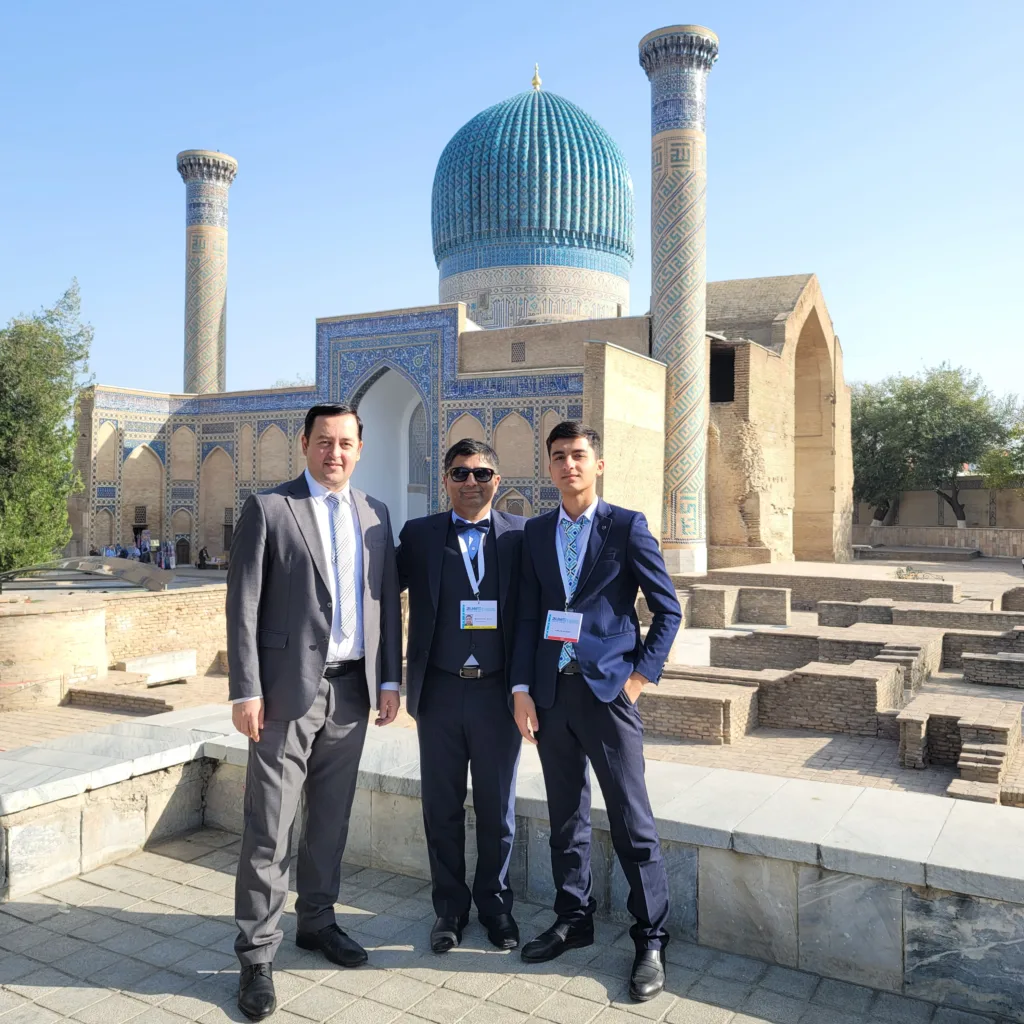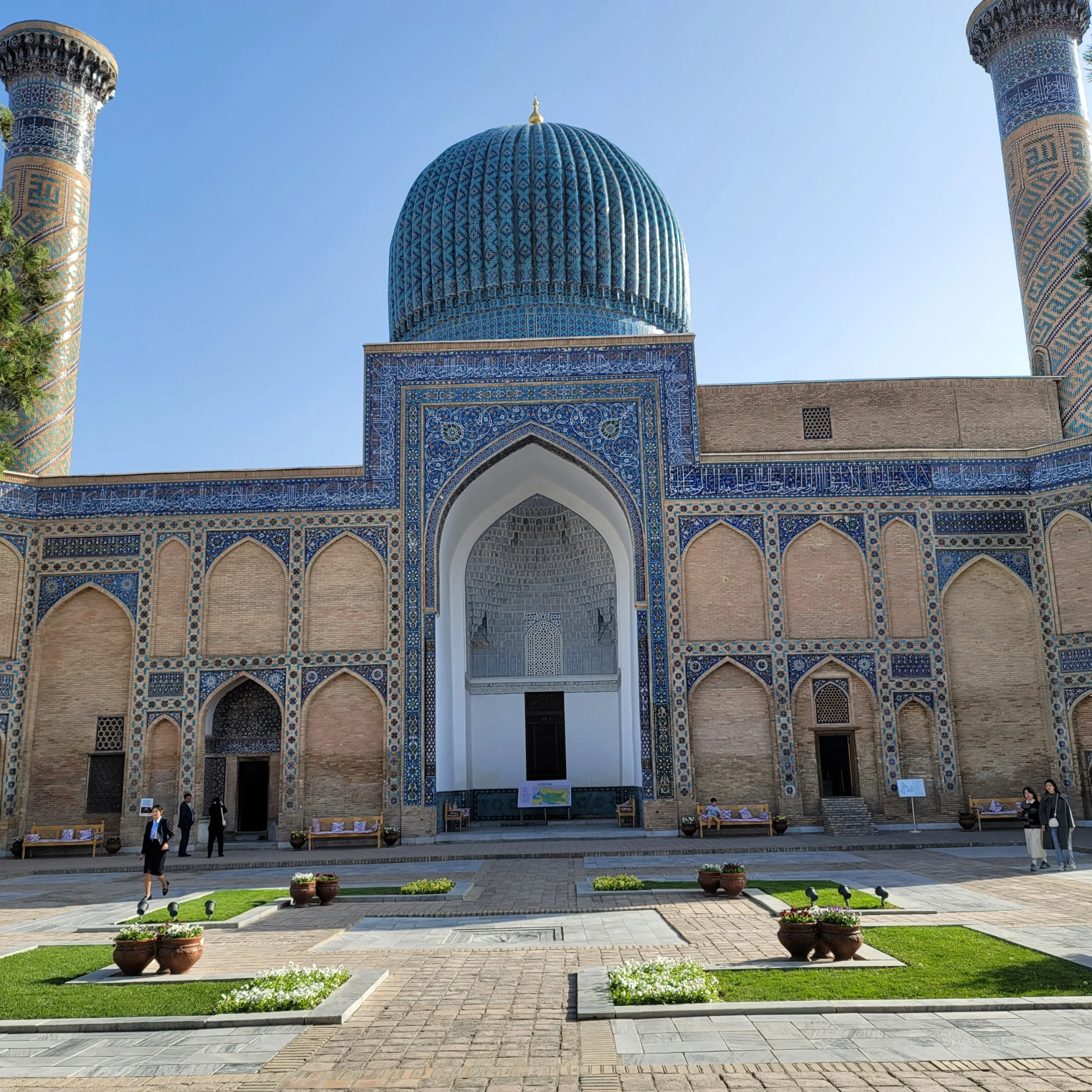I visited Gur-e-Amir on October 17, 2023, and it is a remarkable historical building with a glorious past of Samarkand. The Mausoleum stands as a testament to the powerful and complex legacy of Amir Timur known as Tamerlane, a great conqueror who shaped the Central Asian history in the late 14th century. This architectural marvel, situated in Samarkand, Uzbekistan, serves as the final resting place for Timur and several of his descendants. The mausoleum’s history is intertwined with the grief of a grandfather, the sudden demise of a promising heir, and the ambitious vision of a conqueror who sought immortality through monumental construction.
The Origin of Gur-e-Amir
Dr. Farruxbek Olim explained me that originally, the site of the Gur-e-Amir was a khanqah and madrasa, established by Timur’s grandson, Muhammad Sultan. The architectural arrangement of these buildings, facing each other across a spacious courtyard in a qosh configuration, reflects an early application of urban planning principles later widespread in Central Asia. However, tragedy struck in 1403 when Muhammad Sultan died at the age of 27. Timur, devastated by the loss, ordered an extended period of mourning and the construction of an elaborate tomb for his beloved grandson.
The Construction
For the initial two years after Muhammad Sultan’s death, the tomb served as a grand mausoleum reflecting Timur’s scale and ambition. However, fate had other plans, and Timur, the conqueror himself, met his end merely two years later while on a campaign to conquer China. Despite having a tomb built in Shahrisabz, the harsh winter conditions forced a change of plans, leading to Timur’s burial alongside Muhammad Sultan in the central chamber of Gur-e-Amir.

Dynastic Mausoleum
As the years passed, Gur-e-Amir transformed into the dynastic mausoleum of the Timurid dynasty. Timur’s tomb became surrounded by three more graves – those of his spiritual adviser, Sayyid Baraka, his grandson Ulugh Beg, the renowned astronomer king, and one of his sons, Shah Rukh Mirza. With the addition of more relatives’ graves, the mausoleum solidified its status as a revered site for the Timurid legacy.
Dr. Farruxbek Olim further explained to me that despite its rushed construction – allegedly completed in just 10 days according to the Castilian ambassador Clavijo – the Gur-e-Amir showcases impeccable workmanship. The interior of the tomb chamber is a masterpiece of papier-mache muqarnas vaulting adorned with gilded kundal, providing a three-dimensional effect. The small cenotaphs, seemingly overshadowed by the grandeur, conceal the actual sarcophagi located in a hidden chamber underground.
The exterior of Gur-e-Amir is equally majestic, with a high dome and a prominent entrance pishtaq. The late 14th-century trend of magnifying a single feature is evident, as seen in other grand tombs of the era. The towering dome, supported by a tall cylindrical drum, utilized advanced architectural techniques, including a hidden inner dome and cross-bracing, suggesting the influence of Persian architects, likely conscripts of Timur.
Over the centuries, Gur-e-Amir suffered from neglect, with weathering and collapse threatening its existence. Soviet restorationists intervened in the 1950s, effectively preserving the tomb chamber, entry portal, and north-facing pishtaq. Sergey Prokudin-Gorsky’s early 20th-century photographs highlight the extent of deterioration, contrasting with the meticulous restoration efforts that have made it challenging to distinguish between original elements and restored areas.
Conclusion
The Gur-e-Amir Mausoleum stands as an important symbol of Timur’s legacy and the Timurid dynasty’s influence on Central Asian history. Beyond its architectural splendor, the mausoleum encapsulates the grief, ambition, and the enduring impact of a conqueror and his descendants. Today, Gur-e-Amir continues to attract visitors, offering a glimpse into the rich history of Central Asia and the enduring legacy of Amir Timur.

Mr. Muhammad Ali Pasha is an analyst and expert on Central Asia, South East Asia, China, Türkiye and Middle East having experience in the field of article writing in various renowned journals and newspapers across the globe. Furthermore, he is a writer and poet.


